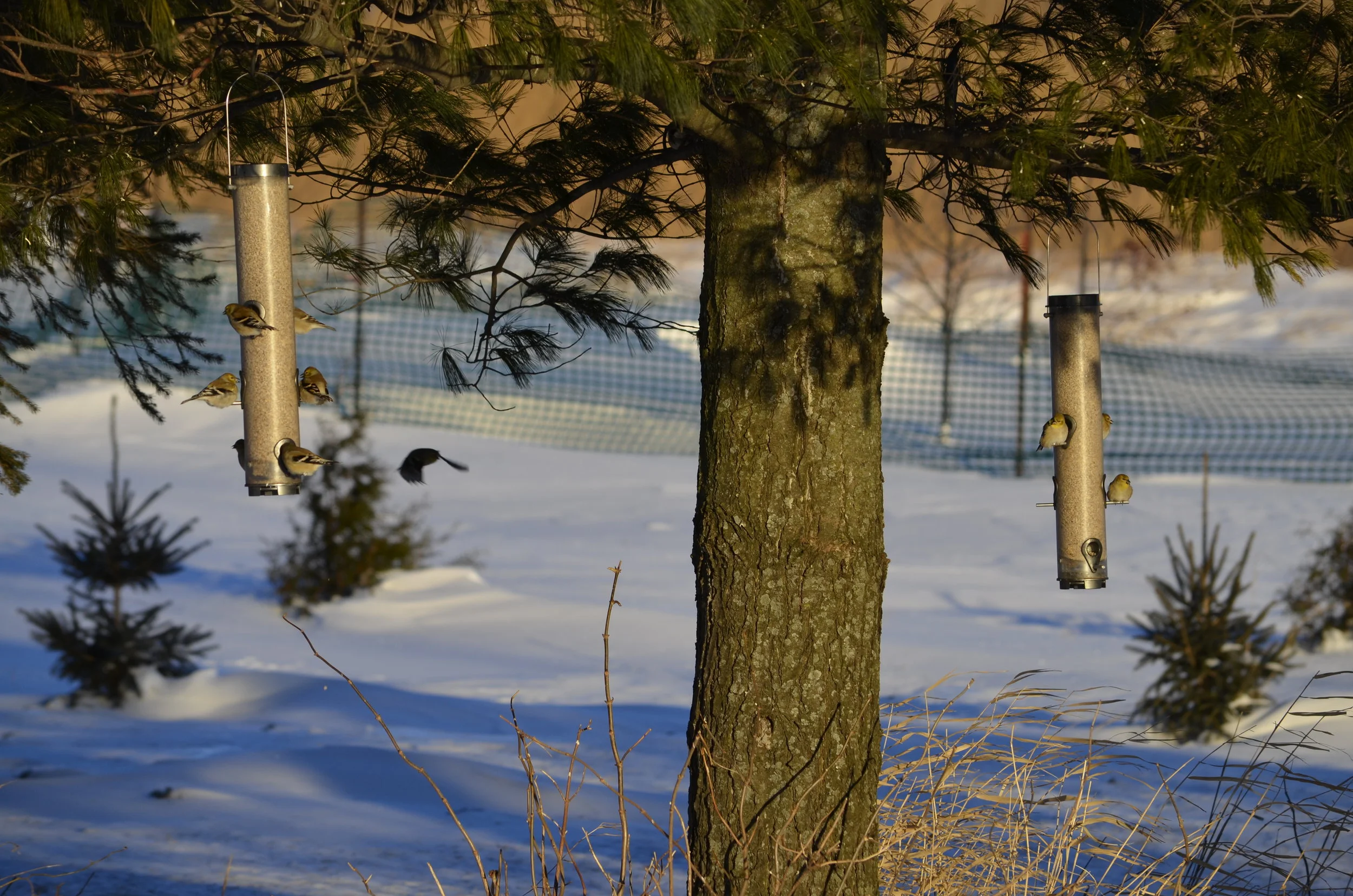This year marks the 20th Great Backyard Bird Count (GBBC), coordinated by the Cornell Lab of Ornithology, National Audubon, Bird Studies Canada, and eBird. Over 160,000 people across the globe spend a chilly February weekend (this year: Feb. 16-19) simultaneously taking a snapshot of the distribution and abundance of birds by counting and submitting online the number of species and individual birds they find in their yards. It’s a fun and comfortable way to participate in citizen science, especially during 2018 -- the Year of the Bird!
Snowy owl, photo by Monica Hall
Mark Martin and Sue Foote-Martin, who are year-round residents and managers at Goose Pond Sanctuary, have participated in the GBBC since 2001. Maddie Dumas, Goose Pond land steward, is in her second year of GBBC. Birds can also be counted and reported from anywhere, not just backyards. For example, Mark and Curt Caslavka, longtime friend and volunteer at Goose Pond Sanctuary, reported a snowy owl on Feb.16, seen across Highway County I directly west of Jill’s Prairie.
Each year brings the regular characters to the count: blue jays, black-capped chickadees, tree sparrows. Some years bring unusual faces, like ring-necked pheasants, and some years bring bumper crops of other species. This year, thanks to the GBBC, we have a new record of 110 common redpolls for Goose Pond Sanctuary, surpassing the record of 50 birds seen by Aaron Stutz in 1997. The high count in Wisconsin for common redpolls was a flock of 150 in Langlade County.
House finches (with the red faces and breasts) and common redpoll (with the red cap) feasting during the GBBC. Photo by Maddie Dumas
We kept close watch of the bird feeders at both Goose Pond residences on Monday, February 19, the last day of the four-day Great Backyard Bird Count. Mark and Sue were surprised to see a large flock of winter finches flying back and forth from the spruce windbreak to the ash trees in the Kampen Road residence and identified them as common redpolls. The flock stayed high up in the spruce and only one redpoll was seen at the sunflower fine feeders.
The Martins also checked their feeders at their cabin (Wildland) north of Rio in Columbia County. The habitat around the cabin consists of restored prairie, oak savanna and wetland. This setting provided the greatest diversity of bird species (see spreadsheet), totaling 19 as compared to 6 species at the Kampen Road residence and 9 species at the Prairie Lane residence.
Goldfinch (top left), common redpoll (bottom center), and pine siskins (all the rest) converge on one feeder at Wildland. Photo by Mark Martin
The Goose Pond residences are in an open landscape with few trees and restored prairie within one half mile of a wildlife food plot of sunflowers and sorghum. The food plot helps attract birds to the area. Mourning doves, American tree sparrows, common redpolls, and American goldfinches have been in the food plot since December and move back and forth to the residences.
Ring-necked pheasants are uncommon in the GBBC and Maddie found a pair feeding at her feeders. Good numbers of mourning doves and American tree sparrows were found at all three residences. Pine siskins are also more common in Wisconsin this winter and have been feeding in high numbers at the Wildland feeders for many weeks.
Factors contributing to the higher species count and higher number of individuals included more diverse habitat, the number and types of feeders, and the variety of seeds present. We find that the best seeds for us are black-oil sunflowers, sunflower fines, white millet, and suet. Nine of the 20 species observed at three feeders were in the top 10 species recorded world-wide in 2017 (see spreadsheet).
On Thursday afternoon, February 22 GBBC reports were still being entered. Thursday totals included 160,000 checklists, 6,031 species and 25,300,000 birds counted. This is an impressive number that reflects on the number of people interested in birds. In Wisconsin, birdwatchers submitted 2,400 checklists and reported 121 species.
Downy woodpeckers munching on suet. Photo by Mark Martin
We really enjoy counting birds and participating in the GBBC that gives us a snapshot of bird usage at our feeder in late winter. Thanks to everyone that feeds the birds, and if you live in suitable habitat we encourage you to begin feeding the birds. Winter feeding, in particular, can make the difference in helping some species make it through cold and snowy weather. The color and variety of species brighten our winter days and make us feel good knowing that we can provide them with quality habitats and nutritious food.
P.S. This time of year is a good time to start thinking about planting native shrubs and plants for wildlife habitat in your yard! Check out this list of nurseries that sell Wisconsin native plants and offer lots of resources like catalogs, planting recommendations, and more. Dream big and make your yard a little haven for birds (you’ll be making it a haven for lots of other great wildlife as a byproduct, too!).
Written by Mark Martin and Susan Foote-Martin, Goose Pond Sanctuary resident managers, and Maddie Dumas, land steward
Header photo: Common redpoll, by Emily Meier








